A week ago it cost 600 baht (£11.50) to visit the tiger temple in Thailand’s Kanchanaburi province, west of the capital, Bangkok. Tourists moved by the spectacle of such splendid creatures living side by side with human beings could also pay the saffron-robed Buddhist monks an extra £15 to help feed the cubs, or to have their picture taken with an adult tiger’s head resting on their lap.
Along with nearly 250,000 people, Jay Z, Beyoncé and their daughter Blue Ivy posed with the animals last year, and marvelled that some of the world’s fiercest creatures could be so tame.
Now the doors of the temple have been closed and the animals removed, possibly for ever. After a decade of allegations by animal groups of cruelty, illegal wildlife trafficking and breeding, 1,000 police, military and government officials descended on the temple to expose a shadowy trade in tiger parts that feeds an insatiable market in China and threatens the few remaining tigers in the wild.
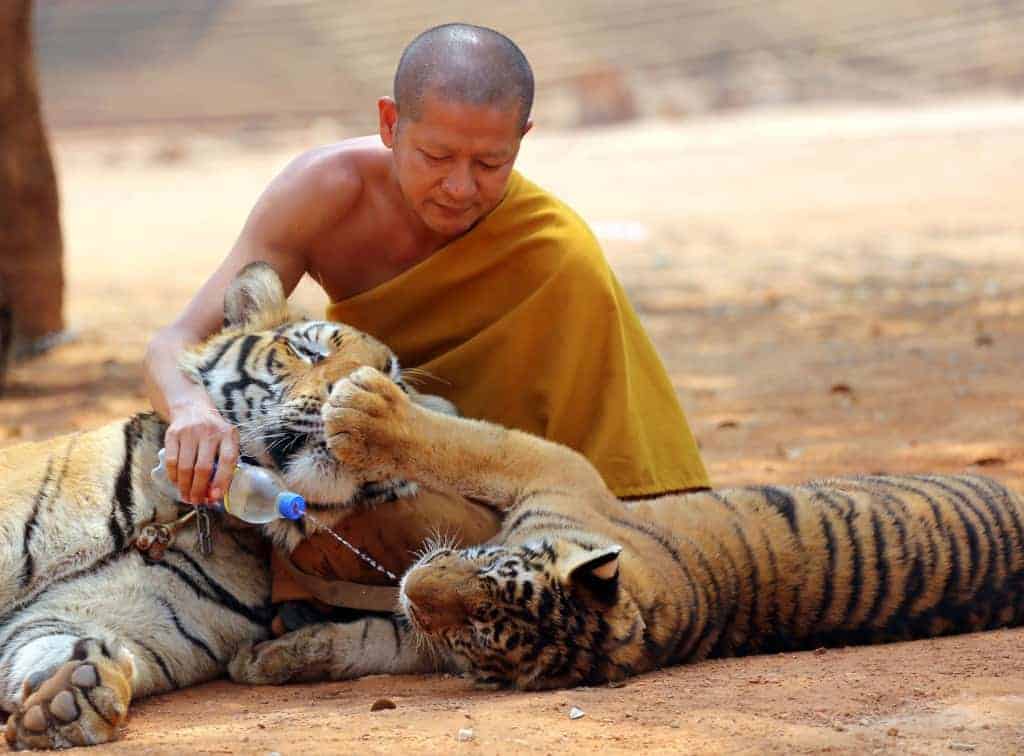
Debbie Banks of the EIA has worked undercover at tiger farms in China. She says that for the past decade, tiger breeding has been a fast-expanding and lucrative industry, often masquerading as conservation. The existence of the farms is stoking demand for luxury products and traditional Chinese medicines, and endangering the few tigers left in the wild.
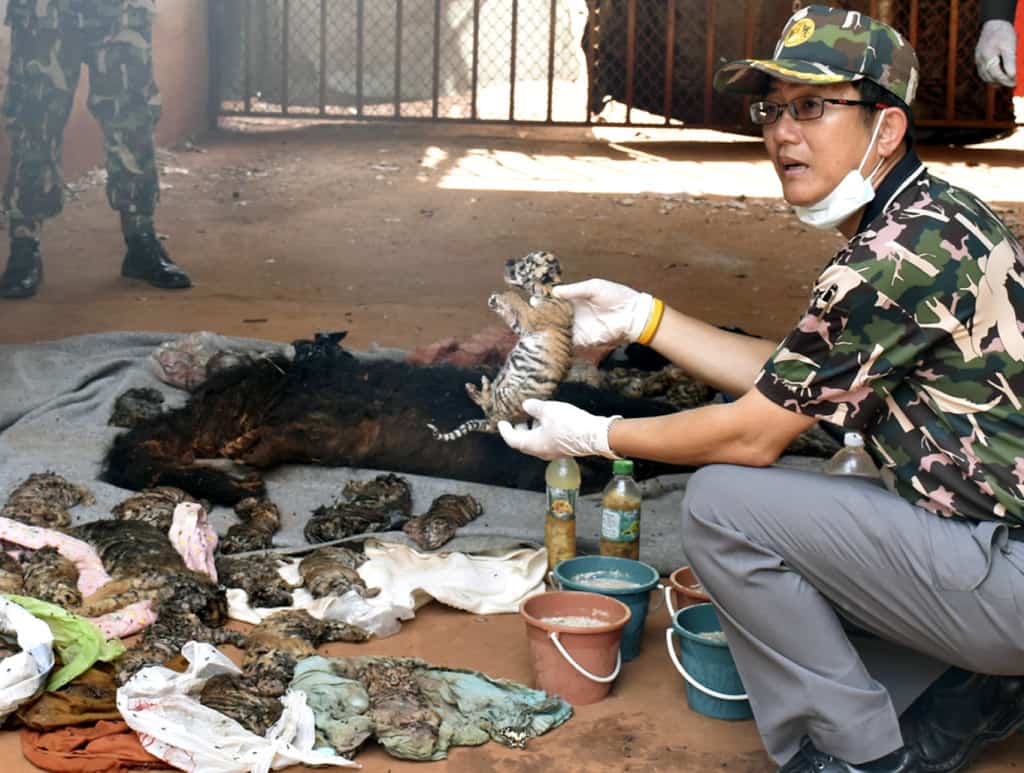
In Kanchanaburi, what was found out of sight of the tourists shocked even hardened wildlife investigators. Apart from 137 live tigers, they found a laboratory, suggesting that the monks were using tiger parts to make wines and medicines – as well as the carcasses of 40 cubs stored in a freezer.
Farms such as these – which have grown in number and size in response to rising demand for tiger bone and other body parts, and the precipitous decline in wild tigers – say they are making people aware of the tigers’ plight and claim that their captive-bred animals could be returned to the wild.
Banks is scornful: many such “facilities” are breeding tigers for profit, she says, and most are suspected of being involved in the illegal selling or trading of tiger parts.
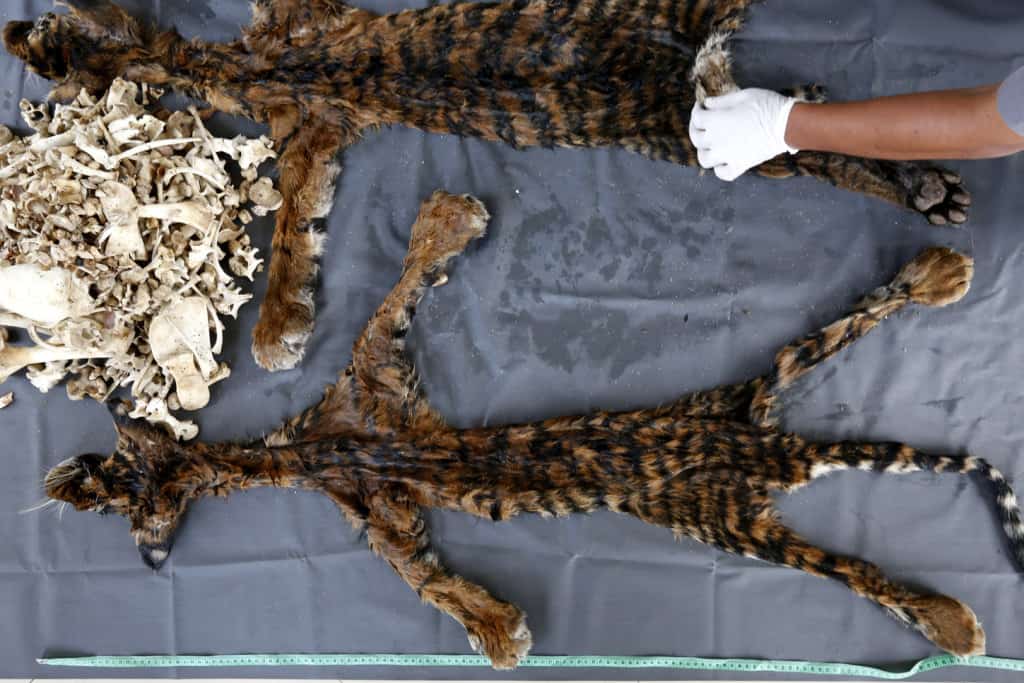
Despite an international agreement in 2007 stipulating that tigers should not be bred for trade in parts, and that tiger farms should be phased out, the opposite has happened, with the trade in body parts from captive tigers rising, and the demand for wild tigers higher than ever.
Traffic says that parts of around 1,600 tigers were seized by Asian authorities between 2000 and 2014. “It’s hard to break down which were wild and which captive, but they could not have all been wild tigers,” said spokesman Richard Thomas.
“Many of the hundreds of tiger part seizures in Asia appear to be from captive-bred animals, and Traffic has previously called upon a number of countries, including Thailand, to demonstrate what controls are in place to prevent such illegal trade taking place.”
Yet business is booming. The authors of a 2014 report, commissioned for Cites (the Convention on International Trade in Endangered Species of Wild Fauna and Flora), the world regulator of trade in protected wildlife, said: “An increasing number of live animals and frozen bodies are being detected, with more than 50% of seizures over the past 14 years occurring since 2010. It is suspected that many of these are of captive origin.
“Seizures of suspected captive-origin tigers have risen in Laos, Thailand and Vietnam, and evidence suggests that such trade is also taking place in Indonesia.”
The strong suspicion is that corrupt authorities and powerful businessmen are behind the billion-dollar trade in tiger parts. “China has systematically exercised internal trading privileges for companies dealing in skins and derivatives, produced mainly but not exclusively from captive breeding,” says the Cites report.
Despite international bans on the trade, porous borders between Thailand, Myanmar, Laos and China allow traffickers to easily export animals. Two weeks ago, a 26-year-old Vietnamese man was found with four frozen tiger cubs at the Laos border. He said he had bought the carcasses at a border market for 2 million Vietnamese Dong (£62) and was delivering them to a buyer.
Once the tiger parts reach China, the rewards are immense. For decades, tiger parts, used in traditional medicine, drove the black market trade. It has been forbidden to use tiger bones in China since 1993, but John Scanlon, secretary-general of Cites, says there has been an expansion in demand for some species, from buyers keen to display their wealth.
“This is most evident with the use of rhino horn and tiger parts. This is part of a shift from traditional culture-related consumption to conspicuous consumption, which is also affecting many other species pressured by illegal trade,” said Scanlon.
A skin from a fully grown farmed tiger can sell for around £40,000 in China. According to EIA, wealthy Chinese are buying pelts for rugs and wall hangings, and drinking tiger wine at $500 (£340) a bottle. Tiger bones are worth almost their weight in gold, and a bowl of tiger penis soup – said to boost virility – sells for more than $300.
There only around 50 tigers left in the wild in China, but two large tiger farms and many smaller ones legally hold some 5,000 animals. Some countries have argued that captive breeding of endangered animals can relieve the pressure on wild animals. But while this may be true with crocodiles, it is thought to actually increase demand for tiger parts, says the World Wide Fund for Nature (WWF).
“We don’t want to see tigers commercialised in any way,” said Colman O’Criodain, WWF’s wildlife trade specialist. “The fact is, the wilder the tiger, the better the medicine is considered. It’s also very expensive to rear tigers in captivity. With the difficulty of separating farmed products from wild ones, it’s too much of a risk. There is too much temptation to cash in.”
Associated PressNational Parks and Wildlife officers examine the skin of a tiger at the “Tiger Temple,” in Saiyok district in Kanchanaburi province, west of Bangkok, Thailand, Thursday, June 2, 2016.Banks added: “Tiger farms have nothing to do with conservation of wild tigers. On the contrary, both legal and illegal trade in parts and products from these horrific facilities are stimulating demand, which drives the poaching and extinction of wild tigers.”
Campaigners hope that the horrors of Kanchanaburi will stir the world’s conscience. But for the trade in one of the world’s most impressive creatures to end, there may need to be another cultural revolution in China.
Associated PressTiger skin and bone products are laid out on a table by National Parks and Wildlife officers at the “Tiger Temple,” in Saiyok district in Kanchanaburi province, west of Bangkok, Thailand, Thursday, June 2, 2016.Tigers in danger
There are about 3,200 tigers in the wild. Fewer than 30 in Vietnam, 50 in China, 2,200 in India and about 500 in Russia.
There are more than 7,000 tigers being bred in captivity in 240 farms in SE Asia. China has 5,000 captive tigers, Thailand 1,450, Vietnam 180 and Laos around 400.
The skin, meat, bones and claws of tigers are all prized for luxury goods and traditional medicine.
The equivalent of 1,590 dead tigers were seized between 2000 and 2014.
About 30% of the illegal tiger parts seized in Asia are suspected to have come from farms.
This article was first published by The Guardian on 04 Jun 2016.
We invite you to share your opinion whether tiger farming and trade in tiger parts should be banned? Please vote and leave your comments at the bottom of this page:
Thank you for voting.


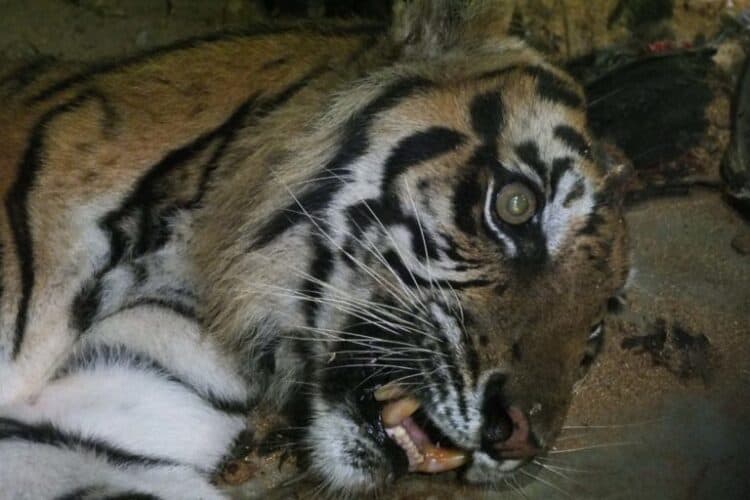

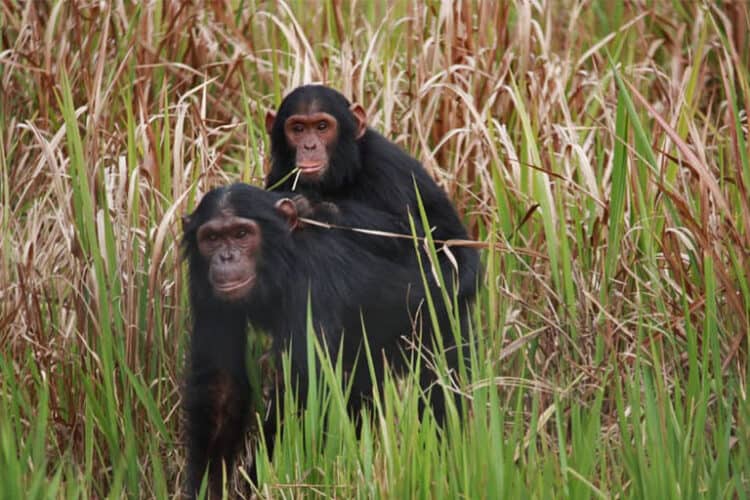

Leave a Reply